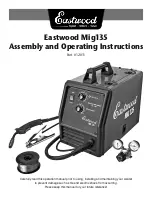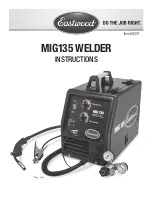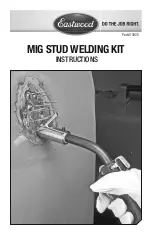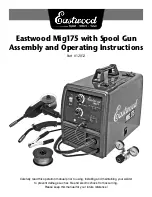
PERSONAL SAFETY
CAUTION
Keep the work area well lit. Make sure there
is adequate space surrounding the work area.
Always keep the work area free of obstructions,
grease, oil, trash, and other debris. Do not use
equipment in areas near flammable chemicals,
dust, and vapours. Do not use this product in a
damp or wet location.
1. Stay alert, watch what you are doing and use
common sense when operating equipment.
Do not use a tool while you are tired or under
the influence of drugs, alcohol or medication. A
moment of distraction when operating equipment
may result in serious personal injury.
2. Do not overreach. Keep proper footing and
balance at all times. This enables better control of
the power tool in unexpected situations.
ARC RAYS CAN BURN EYES AND SKIN
DANGER
Arc rays from the welding process produce
intense heat and strong ultraviolet rays that can
burn eyes and skin.
1. Use a Welding Helmet or Welding Face
Shield fitted with a proper shade filter
(refer AS 60974-1, AS/NZS 1337.1 and
AS/NZS 1338.1 Safety Standards) to protect
your face and eyes when welding or watching.
(See Filter Table on Page 6).
2. Wear approved safety glasses. Side shields
are recommended.
3. Use protective screens or barriers to protect
others from flash and glare; warn others not to
watch the arc.
4. Wear protective clothing made from durable,
flame-resistant material (wool and leather) and
foot safety protection.
5. Never wear contact lenses while welding.
NOISE CAN DAMAGE HEARING
CAUTION
Noise from some processes can damage
hearing. Use AS/NZS compliant ear plugs or ear
muffs if the noise level is high.
WORK ENVIRONMENT SAFETY
DANGER
Remove any combustible material from the work area.
1.
When possible, move the work to a location well
away from combustible materials. If relocation
is not possible, protect the combustibles with a
cover made of fire resistant material.
2.
Remove or make safe all combustible materials
for a radius of 10 meters around the work area.
Use a fire resistant material to cover or block all
doorways, windows, cracks, and other openings.
3.
Enclose the work area with portable fire resistant
screens. Protect combustible walls, ceilings,
floors, etc., from sparks and heat with fire
resistant covers.
4.
If working on a metal wall, ceiling, etc., prevent
ignition of combustibles on the other side by
moving the combustibles to a safe location.
If relocation of combustibles is not possible,
designate someone to serve as a fire watch,
equipped with a fire extinguisher, during the
welding process and well after the welding is
completed.
5. Do not weld or cut on materials having a
combustible coating or combustible internal
structure, as in walls or ceilings, without an
approved method for eliminating the hazard.
6.
After welding, make a thorough examination for
evidence of fire. Be aware that visible smoke or
flame may not be present for some time after
the fire has started. Do not weld or cut in
atmospheres containing dangerously reactive
or flammable gases, vapours, liquids, and dust.
Provide adequate ventilation in work areas
to prevent accumulation of flammable gases,
vapours, and dust.
7.
Do not apply heat to a container that has held an
unknown substance or a combustible material
whose contents, when heated, can produce
flammable or explosive vapours. Clean and purge
containers before applying heat. Vent closed
containers, including castings, before preheating,
welding, or cutting.
ELECTRICITY CAN KILL
DANGER
Touching live electrical parts can cause fatal
shocks or severe burns. The electrode and work
circuit is electrically live whenever the output
is on.
The input power circuit and machine internal
circuits are also live when power is on. In
semi-automatic or automatic wire welding, the
wire, wire reel, drive roll housing, and all metal
parts touching the welding wire are electrically
live. Incorrectly installed or improperly grounded
equipment is a hazard.
1.
Do not touch live electrical parts.
2.
Wear dry, hole-free insulating gloves and body
protection.
3. Insulate yourself from the work and the ground
using dry insulating mats or covers.
4. Disconnect input power before installing or
servicing this equipment. Lock input power,
disconnect switch open, or remove line fuses so
power cannot be turned on accidentally.
5. Properly install and ground this equipment
according to national, state, and local codes.
6. Turn off all equipment when not in use.
Disconnect power to equipment if it will be left
unattended or out of service.
7. Use fully insulated electrode holders. Never dip
the holder in water to cool it or lay it down on the
ground or the work surface. Do not touch holders
connected to two welding machines at the same
time or touch other people with the holder or
electrode.
8. Do not use worn, damaged, undersized, or poorly
spliced cables.
9. Do not wrap cables around your body.
10. Connect the work piece to a good electrical
ground.
11. Do not touch the electrode while in contact with
the work (ground) circuit.
12. Use only well-maintained equipment. Repair or
replace damaged parts as soon as practical.
13. In confined spaces or damp locations, do not use
a welder with AC output unless equipped with a
voltage reducer.
ZZZVWUDWDFRQ]





































